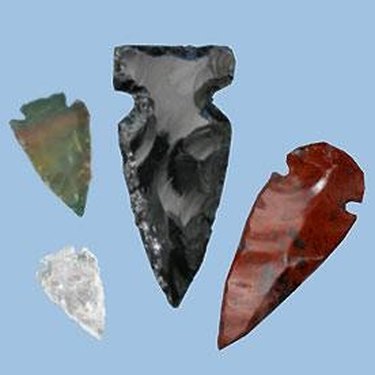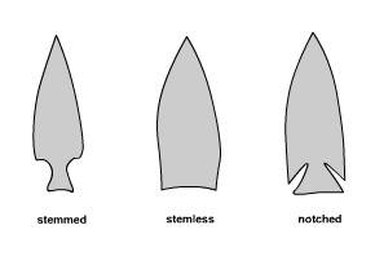Things You'll Need
Flint, chert, obsidian or another rock that flakes easily when struck
Hammer or hard rock

Stone tools have evolved greatly since the first ones were used to chop carcasses in Africa 2.5 million years ago. Though the methods evolved as humans did, and became increasingly sophisticated, one thing rarely changed: the material. Flaking stone like obsidian, chert, and flint were used by Native Americans to make arrowheads for hunting and fishing up until about 200 years ago. They're still made for craft purposes and for the occasional wilderness survival aficionado today. The stones that were favored by our ancestors are still useful in modern times: in fact, an obsidian edge is so sharp, it's occasionally used by surgeons today in place of manufactured steel scalpels.
Step 1

Decide what kind of shape you'd like your arrowhead to have. There are approximately 10 types of arrowheads, but they boil down to three primary forms: stemmed, stemless and notched. You may choose a type based on how you're planning to use it--for example, if you're fixing the arrowhead to the end of a stick for use as a spear, a notched or stemmed arrowhead will be easier to fasten.
Video of the Day
Step 2
Find or purchase a chunk of flint, chert or obsidian. Traditionally, arrowheads are between 35 and 100 millimeters in length, and they're made out of a flake off of a core piece of stone, so select a "core" of flint, chert or obsidian that is larger than 100 mm square. All are easy to find in many parts of the world, and have been used for stone tool-making since the Stone Age. Obsidian is a volcanic rock, made of hardened lava, so it can be found in old or active volcanic sites. Flint and chert are easy to find in the American Midwest, in particular abundance in Illinois. If you're interested in a specific stone that is not native to your area, check out eskimo.com, which has a list of stone sources (see Resources).
Step 3
Place the stone on a rock or a flat wooden surface. Hang one half of the stone off the surface and strike the stone with your rock tool or a hammer. Pieces will flake off, and when you find one that is the thickness and length you desire, this will be the piece that you'll fashion the arrowhead out of. Again, arrowheads are between 35 and 100 mm long on average, and 8 to 20 mm wide. Regarding thickness, pick the thinnest flake possible, as they make the most lightweight and historically-accurate arrowheads.
Step 4
Use your stone tool or hammer to gently form your arrowhead into a crude triangular shape. Rest the piece of flint on a flat surface, and work with the direction that the stone flakes in to prevent the piece from breaking too easily.
Step 5
Continue to gently hammer along the edges of the point. Make a more uniform shape by flaking off any crude edges. By chipping off smaller flakes at a time, you'll create a more artisan arrowhead, and it will have sharper edges. Aim to create a very thin, sharp edge, all around the arrowhead. In archeology, arrowheads are referred to as "projectile points." This name was chosen because the tools were sharp, like a "point."
Tip
If you are creating a notched arrowhead, a metal file is a useful tool to create that thin indentation without destroying the integrity of the arrowhead. gently saw into the base of the arrowhead, either at a diagonal or parallel to the base, depending on the shape you selected.
Video of the Day